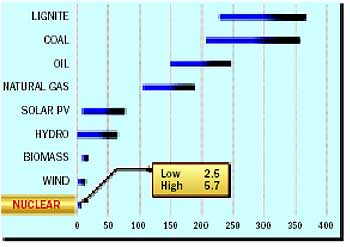

Position Paper on Nuclear Energy’s Contribution
to a post-2012 Climate Policy
In developing a post-2012 climate framework,
it is essential to take into account the valuable contribution
that nuclear energy makes to the avoidance of greenhouse
gas emissions. Nuclear is therefore an important tool – among
many – that can be used to reduce CO2 emissions.
All available options, including nuclear energy, should
be supported in the international effort to reduce the
threat of global warming.
|
FORATOM, as the voice of
the nuclear industry in Europe, makes the following main points
in view of the upcoming discussions on a ‘post-2012’ international
climate regime. FORATOM believes:
-
When addressing climate change, we encourage policy-makers
to consider zero and low emitting electricity generating
technologies, including nuclear energy.
-
The nuclear power
sector can play
an even greater role in greenhouse gas abatement through
the construction of new nuclear plants, plant lifetime
extensions and plant upgrades. The Intergovernmental Panel
on Climate
Change (IPCC) believes that nuclear should continue to
play an important role in the overall effort to curb greenhouse
gas emissions in the decades to come1.
-
Nuclear energy
should
not be penalised in policy mechanisms designed to help
address climate change, as it has been in CDM and JI projects
and
the
EU’s Linking Directive. All technologies that can
help fulfil the purpose of the CDM and JI, as defined
in the protocol,
should be eligible for use in those mechanisms.
-
The
time frame of policy cycles concerning climate change
do not coincide
with that of the energy sector in which an investment
decision is made on a mid- to long-term basis. Current
obligations
under the Kyoto Protocol and EU Emissions Trading
Scheme are limited
to the 2008-2012 period. The absence of certainty
regarding future obligations after 2012 could create excessive
commercial risks. A long-term view must be maintained.
-
If emissions
trading is to be used as a policy measure to
address climate change then emissions trading schemes must
be
structured
in a way that provides the long-term certainty
that
will encourage
the use of low carbon technologies, such as nuclear
power, as emissions reduction options.
-
All countries
have the sovereign right to determine their own development
paths
and technology
needs. They should retain the freedom to
choose nuclear
as part of their development strategies,
without their
choices
being constrained by an international agreement.
Nuclear Energy and Greenhouse
Gas Emissions Avoidance
The current use of nuclear energy (accounting for
about 15% of the world’s electricity generation) avoids
the emission of about 2.1 billion tonnes of CO2eq every year. In the EU as whole, the avoidance levels amount to
675 million
tonnes of CO2eq per year, taking into account the
current energy mix. By comparison, the EU has a greenhouse gas
(GHG) emission
reduction target of 446 million tonnes of CO2eq equivalent below 1990 level by 2008-2012. To make savings equivalent
to those
from the use of nuclear power, all passenger cars in the EU (212
million) would have to be taken off the roads.

Source: IAEA (2000)
Ranges of total GHG emissions from different
electricity production chains, expressed in grams of carbon
equivalent per kilowatt-hour of electricity generated.
The ranges reflect differences in factors such as conversion
efficiencies, local plant conditions, fuel transport requirements,
the fuel mix assumed for electricity requirements related
to plant construction and manufacturing equipment and the
upstream components of the fuel cycle. |
Furthermore, nuclear power plants generate electricity with
hardly any emission of sulphur dioxide or nitrogen oxides, key
agents for acid rain and photochemical air pollution. Thanks
to nuclear, emissions of about 4.8 million tonnes of sulphur
dioxide and 2.6 million tonnes of nitrogen oxides are avoided
each year in the EU.
We need to build upon the current contribution
of nuclear energy to meet our environmental objectives. We
should maximise the utilisation of our existing nuclear capacity
and
build new nuclear power plants to meet the significant demand
for new capacity that will occur over the next few decades. Conclusion
Nuclear power makes a major contribution limiting
the increase in greenhouse gas concentrations in the power generation
sector,
while facilitating access to abundant electricity at a stable
and low cost. Any future climate change agreements and policies
should establish a framework that enables the use of the
nuclear generation option as part of the energy mix .
1 IPCC
Fourth Assessment Report (2007) – Work
Group III Report “Mitigation of Climate Change”. |

